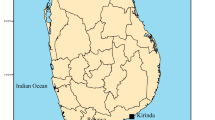Abstract
Nearly 30% of the coastline of Malaysia is undergoing erosion. Many of these areas are coastal mudflats, fringed by mangroves. Behind the mangroves there are usually agricultural areas that are protected by bunds from tidal inundation. These bunds are constructed by the Department of Irrigation and Drainage and it is the policy of the department to maintain a strip of mangroves between the bunds and the sea. Mangroves are known to reduce wave energy as waves travel through them. Thus, mangroves are used to protect the bunds from eroding. However, mangroves themselves are susceptible to erosion. Finding the best method in using this natural system of coastal protection is therefore important to the Department of Irrigation and Drainage. This paper looks at the various methods of using the systems developed to date.
Similar content being viewed by others
References
Economic Planning Unit, Malaysia, National Coastal Erosion Study: Phase 1, Report submitted by Stanley Consultants, Inc., Jurutera Konsultant (S.E.A.) Pte. Ltd. and Moffatt & Nichol, Engineers to the Government of Malaysia, September 1985.
Othman, M. A., Sungei Burong Escarpment — A Combined Structural and Natural Method of Coastal Protection, Proceedings of Conference on Coastal Engineering for National Development, IEM-ICE, Kuala Lumpur, March 1991
Author information
Authors and Affiliations
Rights and permissions
About this article
Cite this article
Othman, M.A. Value of mangroves in coastal protection. Hydrobiologia 285, 277–282 (1994). https://doi.org/10.1007/BF00005674
Issue Date:
DOI: https://doi.org/10.1007/BF00005674




